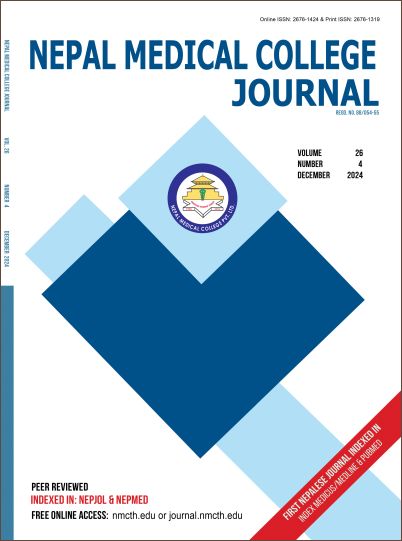Study of Clinical and Mycological Patterns of Dermatophytosis and Sensitivity Pattern of Dermatophytes in Nepal
DOI:
https://doi.org/10.3126/nmcj.v26i4.74452Keywords:
Dermatophytosis, clinical pattern, antifungal sensitivity, NepalAbstract
One of the most common reasons for outpatient visits to the dermatology departments are superficial fungal infections. There has been an emergence of chronic and recalcitrant superficial fungal infections not responding to conventional antifungal agents in our parts of the world. This has become a significant public health issue where patients spend their money first on over-the-counter topical Fixed Drug Combination (FDC) creams containing steroid and then on visiting numerous physicians and dermatologists due to the recalcitrant nature of infection. One of the ways of overcoming this problem would be to identify the causative agents and determine their sensitivity patterns to the common antifungal agents. This study, therefore, aims to counter this significant public health problem by providing information on identification of these dermatophytes and their sensitivity patterns to the routinely used antifungal agents. The results of this descriptive cross-sectional study done at Dermatology Department of Nepal Medical College in Kathmandu will provide a base for formulating new guidelines on the management of these conditions. The patients diagnosed to have dermatophytosis were registered by dermatologist. Skin scraping was taken from the rim of the skin lesion and further processed for potassium hydroxide (KOH) smear examination, culture and sensitivity test. Out of total 274 patients 150 were male and 124 were female. Most of the patients belonged to the age group 20 to 40 years. Tinea corporis was the commonest followed by tinea unguim, tinea pedis and cruris. KOH smear was positive in 60.94% and culture was positive in 47.4%. Trichophyton spp. was commonest (35.40%) followed by Microsporum spp. (7.67%) among the isolates. In Trichopyton spp. the mean minimum inhibitory concentration (MIC) of itraconazole, ketoconazole, terbinafine, griseofulvin and fluconazole was 0.25, 0.26, 0.32, 2.28 and 5.957μg/ml, respectively. In Microsporum spp., MIC of itraconazole, ketoconazole, terbinafine, griseofulvin and fluconazole was 0.41, 0.9, 0.05, 0.4 and 25.7μg/ml, respectively. Trichophyton spp. is the commonest causative agent of dermatophytosis in our part of the world. MIC of commonly used antifungal drugs like itraconazole and terbinafine are low which signifies that these fungi are still susceptible to these drugs. However, the MIC of fluconazole is high compared to other antifungal drugs.
Downloads
Downloads
Published
How to Cite
Issue
Section
License
Copyright (c) 2024 Nepal Medical College Journal

This work is licensed under a Creative Commons Attribution 4.0 International License.
This license enables reusers to distribute, remix, adapt, and build upon the material in any medium or format, so long as attribution is given to the creator. The license allows for commercial use.




